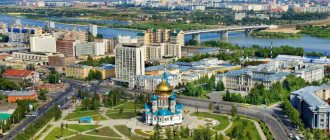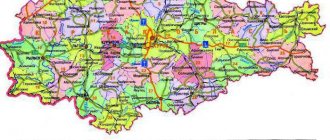Largest cities 500 thousand - 1 million people
Coat of arms of Tomsk
Tomsk
Population 574,002 people (2018). Administrative center of the Tomsk region.
Founded in 1604 as a border fortified city. The city on the Tom River historically developed as the easternmost deep-water port in the Ob River basin, due to which, before the construction of the Trans-Siberian Railway, it was actually the gateway to central and eastern Siberia. Currently, it is a large scientific center, which is facilitated by its proximity to the closed city of nuclear scientists Seversk, which is actually a suburb of Tomsk.
The city, among other things, is home to the Tomsk Tool Plant.
Coat of arms of Seversk
General information about the Tomsk region
Distinctive features . The lands of the Tomsk region began to be developed at the end of the 16th - beginning of the 17th century. The first city in the region, Narym, was founded in 1596. Tomsk was founded in 1604. The indigenous population - the Khanty and Selkup - lived in tents, surrounded by skins or birch bark, and were engaged in hunting and fishing.
Landscape of the Tomsk region
Nature and minerals are the main riches of the Tomsk region. There are large deposits of oil and gas, as well as iron ore, including the Bakcharovskoye iron ore deposit - one of the largest in Russia and the world, its reserves are estimated at 110 billion tons. This is 2 times more than all known iron ore reserves in Russia. In addition to mining, the region has a large nuclear industry enterprise - the Siberian Chemical Plant in Seversk.
Another wealth of the Tomsk region is its human and scientific potential. It regularly takes top places in the innovation rankings of Russian regions. Tomsk is home to a large number of universities, where research institutes, business incubators, and small innovative enterprises have been created. This is the youngest city in Russia. Every fifth resident here is a student.
No, this is not an innovative product. These are just traditional birch bark crafts of the Asinsky region
Unfortunately, ill-conceived economic activities are destroying and destroying the nature of the Tomsk region. To protect it, 19 reserves have been created. Much attention is paid to the development of tourism, because there is something to see here. On the territory of the region there are 145 natural monuments, including Blue Cliff, Vasyugan swamps, Lake Kirek, Talovskie bowls.
Geographical location . Tomsk region is located in Western Siberia, in its southern part. In its neighborhood are: in the south - the Novosibirsk and Kemerovo regions, in the east - the Krasnoyarsk Territory, in the west - the Omsk Region, in the north - the Khanty-Mansiysk Autonomous Okrug. Tomsk region is part of the Siberian Federal District.
The main river of the region is the Ob, into which the Tom, Chulym, Vasyugan and other rivers flow, the total number of which in the region is already 18 thousand, if you count small rivers and streams. The region's topography is low-lying, most of the territory is covered with taiga. If you find yourself in the Tomsk forest, you will find pine, Siberian cedar, spruce, and fir there. There are also a lot of swamps here, the largest of which is Vasyugan.
Vasyugan swamp is one of the largest swamps in the world
Population. 1,064,245 people live on the lands of the Tomsk region. Of these, 71% live in cities. The number of residents in this region has not changed for more than 10 years, which distinguishes it favorably from areas in the European part of Russia or the Far East, where the population is constantly declining. Also encouraging is the positive value of the natural population growth rate (+1.7 people per 1000 inhabitants). In terms of national composition, the Russian population is the leader in the region (88%). Next come the Tatars (1.7%) and Ukrainians (1.2%).
“Siberian Estate Lampasakovo” is a cultural and tourist complex where folk festivals and holidays are held
Crime in the Tomsk region feels at ease and comfortable. Crimes are committed here very often, and in the ranking of regions in terms of the number of crimes per capita, this region ranks 16th. It is worth considering that a high level of crime is generally characteristic of Siberian cities. There are many reasons. This includes drunkenness, lack of prospects, unemployment.
But still, the reason is that the descendants of exiles, convicts, runaways - in general, people from the criminal world - also live in Siberia. Another important factor is the influx of migrants from Siberian villages, who brought their way of life and laws of life to the cities.
The unemployment rate in the Tomsk region in 2012 was 8.41%. This value has remained almost unchanged over the past decade, fluctuating between 7-12%. The average salary in the Tomsk region is 26,294 rubles. This figure only says that there is a wide range of incomes in the region depending on the industry. Very low wages in the textile industry and manufacturing. But on the other hand, oil workers (and in general, in the field of extraction of fuel and energy minerals) have an average salary of 57 thousand rubles, in the field of financial activities - 46.5 thousand rubles.
Asinovsky district is the center of meat and dairy cattle breeding
Property value. One-room apartments in Tomsk are offered at prices starting from 1 million rubles, and the request amount can reach up to 2 million rubles. and higher, depending on the location of the house and the quality of the apartment. Two-room apartments are sold much more expensive, for 2 - 3 million rubles. Three-room apartments are not much different in price from two-room apartments, but luxury apartments with a large area can be sold for 4 or even 9 million rubles.
The climate of the Tomsk region is continental. The winter here is harsh and long, with an average temperature of −20°C in January. Summer is short, with an average July temperature of +18°C. The average annual precipitation is 450-700 mm.
see also
- Tomsk region
- Cities of Russia
| [ + ] Cities by regions of Russia | |
| Cities of the North-West (NWFD) | St. Petersburg (and its cities) • Leningrad region (historical Staraya Ladoga) • Arkhangelsk region • Vologda region • Kaliningrad region • Karelia • Komi • Murmansk region • Nenets Autonomous Okrug • Pskov region |
| Cities of the Volga region (Volga Federal District) | Bashkortostan • Volgograd region • Kalmykia • Kirov region • Mari El • Mordovia • Nizhny Novgorod region • Orenburg region • Penza region • Perm region • Samara region • Saratov region • Tatarstan • Udmurtia • Ulyanovsk region • Chuvashia |
| Cities of Southern Russia (SFD) | Sevastopol (including Inkerman) • Republic of Crimea • Adygea • Astrakhan region • Krasnodar region • Rostov region |
| Cities of the North Caucasus (NCFD) | Dagestan • Ingushetia • Kabardino-Balkaria • Karachay-Cherkessia • North Ossetia - Alania • Stavropol Territory • Chechen Republic |
| Cities of the Urals (Ural Federal District) | Kurgan region • Sverdlovsk region • Tyumen region • Khanty-Mansi Autonomous Okrug - Yugra • Chelyabinsk region • Yamalo-Nenets Autonomous Okrug |
| Cities of Siberia (Siberian Federal District) | Altai Republic • Altai Territory • Irkutsk Region • Kemerovo Region • Krasnoyarsk Region • Novgorod Region • Novosibirsk Region • Omsk Region • Tomsk Region • Tyva • Khakassia |
| Cities of the Far East (FEFD) | Amur Region • Buryatia • Jewish Autonomous Region • Trans-Baikal Territory • Kamchatka Territory • Magadan Region • Primorsky Territory • Sakha (Yakutia) • Sakhalin Region • Khabarovsk Territory • Chukotka Autonomous Region |
| see also | Cities of the DPR, LPR, Transnistria, South Ossetia • Regions of Russia • Cities of Russia |
Cities and towns
| № | Name | district/city of regional subordination | population (persons) | founding/first mention | city/town status | coat of arms |
| 1 | Tomsk | Tomsk | ↘568 508[3] | 1604 | 1629 | |
| 2 | Asino | Asinovsky district | ↗24 442[3] | 1896 | 1952 | |
| 3 | Cedar | Cedar | ↗1918[3] | 1982 | 1987 | |
| 4 | Kolpashevo | Kolpashevo district | ↘22 589[3] | 1600XVII century | 1938 | |
| 5 | Seversk | Seversk (ZATO) | ↘105 858[3] | 1949 | 1954 | |
| 6 | Strezhevoy | Strezhevoy | ↘39 903[3] | 1966 | 1978 | |
| 7 | Bely Yar | Verkhneketsky district | ↘8324[3] | 1930 | 1964 |
Former towns
- Asino has been a town since 1945. Incorporated into a city in 1952.
- Baturino has been a town since 1941. Converted to a rural settlement in 1993.
- Bogashevo has been a town since 1982. Converted to a rural settlement in 1992.
- Dzerzhinsky has been a town since 1990. Converted to a rural settlement in 1993.
- Itatka has been a town since 1964. Converted to a rural settlement in 1992.
- Kargasok has been a town since 1959. Converted to a rural settlement in 1992.
- Kolpashevo has been a town since 1933. Incorporated into a city in 1938.
- Komsomolsk has been a town since 1964. Converted to a rural settlement in 1992.
- Krasny Yar has been a town since 1957. Converted to a rural settlement in 1992.
- Mogochin has been a town since 1933. Converted to a rural settlement in 1992.
- Moryakovsky Zaton has been a town since 1940. Converted to a rural settlement in 1993.
- Narga has been a town since 1982. Converted to a rural settlement in 1992.
- Oktyabrsky has been a town since 1982. Converted to a rural settlement in 1993.
- Samus has been a town since 1934. Converted to a rural settlement in 1994.
- Svetly has been a town since 1982. Converted to a rural settlement in 1992.
- Strezhevoy has been a town since 1967. Incorporated into a city in 1978.
- Timiryazevsky has been a town since 1940. Converted to a rural settlement in 1992.
- Togur has been a town since 1939. Converted to a rural settlement in 1992.
Train Station
On the territory of the city there are two railway stations “Tomsk-I” (central in the Kirovsky district on Kirova Avenue) and “Tomsk-II” (Oktyabrsky district, Vokzalnaya street, 11). From the central railway station there are long-distance trains to Moscow, Chita, Krasnoyarsk, Severobaikalsk, Abakan, Ridder, Vladivostok.
The most popular directions from the Tomsk-II station are Moscow, Novosibirsk, Novokuznetsk, Bely Yar, Anapa, Ridder. Trains also depart from here on suburban routes to Taiga, a city in the Kemerovo region, Basandaika and Asino.
Strezhevoy
Coat of arms of the city of Strezhevoy
The coat of arms of the city of Strezhevoy was adopted on September 8, 2004. At the top there is a bezant of variable colors, from which a black stream flows. In the green field there is a cedar cone with needles, in the silver field there is an oil derrick. The silver field symbolizes the desire to preserve the surrounding nature, the blue field is the land of rivers, lakes and swamps. A tower with a circle and a black stream pouring out of it symbolizes the oil industry. The green field symbolizes the nature surrounding the city. A pine cone indicates forest wealth.
Kolpashevo
Kolpashevo , a city in the Russian Federation, Tomsk region, is located on the right bank of the river. Ob, 270 km (by air) northwest of Tomsk. River port. Road junction. Airport. District center. Population 27.7 thousand people (2001). Founded in the mid-17th century. City since 1938.
Center of the fishing industry. Main enterprises: fish processing plant, shipyard (repair of fishing vessels). . Meat processing plant, poultry factory. Breeding station.
Founded by service people Kolpashnikovs (hence the name); in a document from 1710 it is mentioned as the village of Kolpashnikovo. The history of Kolpashev is inextricably linked with the great water road to the east, which passed along the river. Ket. In the 17th-18th centuries. along this road lay the routes of the embassies of the Russian tsars to China, the routes of the famous Kamchatka expeditions led by V. Bering and A. I. Chirikov. A stream of Russian settlers also moved along Keti, exploring new lands. At the beginning of the 20th century. Kolpashevo turned into one of the largest colonies of Narym political exile. From 1926 - a settlement, from 1933 - a workers' settlement, in 1932-1944. - the center of the Narym district. In the 1920-30s. “enemies of the people” were referred here. The famous Russian poet N.A. Klyuev served his exile in Kolpashevo. Kolpashevsky Yar became notorious - the burial place of victims of Stalin's repressions executed by the NKVD.
There is a branch of the Tomsk United Historical and Architectural Museum in the city.
Historical and architectural monuments: Church of the Resurrection (1818). In the nearest suburb of Kolpashev is the village of Togur, one of the oldest Russian settlements in the middle part of the Ob (first half of the 17th century). There was a settlement at this place in the Middle Ages, and by the time the Russians arrived, according to Selkup legends, there was a fortress called Kirinan-ett.
In the vicinity of Kolpashev, two unique natural monuments attract attention - Svetlye lakes. In the center of one lake there is a “floating island”. In sanatoriums 40 km from Kolpashev, physiotherapy, water and mud therapy is provided in the following profiles: cardiology, neurology, arthrology, pulmonology, gastroenterology, dermatology, gynecology, andrology.
What is the meaning of the name of the city Tomsk?
Architecture and midges. There is a legend that Omsk is an abbreviation that stands for Remote Place of Exile for Convicts, and Tomsk is EVEN MORE Remote Place of Exile for Convicts. ... TOMSK - July 8. The letter “K” shyly hid in the bushes.
Interesting materials:
How many balloons are there in 40 liters of helium? How old is Shatunov Jura? How many chocolates are there in a large Mercy box? How many pieces of Nuggets are there in a pack of Miratorg? How many pieces of ceiling tiles are in a package? How many rolls are there in 1 serving? How long does a dog last? How many cm is Gon? How many cm does a plasterboard ceiling take? How much formula do they give in the dairy kitchen?
Tomsk bus station
Tomsk Central Bus Station is located on Kirova Avenue, 68. Buses from here run both intercity (Tomsk region), and interregional, interregional and international routes to cities and towns of the Altai and Krasnoyarsk Territories, Kemerovo, Tula and Arkhangelsk regions and Kazakhstan.
Popular routes outside the Tomsk region are Krasnoyarsk, Kemerovo, Barnaul, Belokurikha, Vershinino, Gorno-Altaisk, Kireevsk, Mariinsk and others. Bus service is established with the Kazakh cities of Karaganda, Pavlodar and Semey, where buses run 2-3 times a week.










